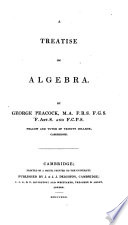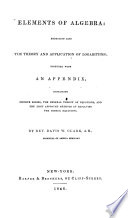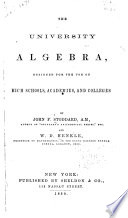 | George Peacock - Algebra - 1830 - 732 pages
...separate terms, in that member of the equation which involves the unknown quantity, into one (3) : divide both members of the equation by the coefficient of the unknown quantity (4), which gives the solution required." 745. In the following examples, reference will be... | |
 | Davis Wasgatt Clark - 1844 - 394 pages
...fractions and the terms reduced, has a coefficient, the reduction may be completed by the following RULE. Divide both members of the equation by the coefficient of the unknown quantity. EXAMPLES. 1. Reduce the equation 13r+31=8.r+76. Transposing .... 13x— 8a;=76— 31. Reducing... | |
 | Davis Wasgatt Clark - Algebra - 1846 - 374 pages
...fractions and the terms reduced, has a coefficient, the reduction may be completed by the following RULE. Divide both members of the equation by the coefficient of the unknown quantity. EXAMPLES. 1. Reduce the equation 13*+31=8a;+76. Transposing - ... 13x—8a;=76 —31. Reducing... | |
 | Benjamin Greenleaf - Algebra - 1853 - 370 pages
...reduce the equation, so that the unknown quantity may be positive, and the first member of the equation. Divide both members of the equation by the coefficient of the unknown quantity; then extract the square root of both members. 3. Given 5z'4-5=3z'+55 to find x. Conditions,... | |
 | John Fair Stoddard, William Downs Henkle - Algebra - 1859 - 538 pages
...unknown terms, when not already done, into one term, and put the second member in its simplest form. 5. Divide both members of the equation by the coefficient of the unknown quantity, and the resulting equation will be the simplest form of the given equation, and will indicate... | |
 | George Edward Atwood - 1900 - 276 pages
...terms containing the unknown quantity into one term, and unite similar terms in the second member. Divide both members of the equation by the coefficient of the unknown quantity. EXAMPLES. . xx K if a — 6 x — 60 = 3* — 2x + 12 x=3 2. ax— b = bx — c ax — bx... | |
 | William James Milne - Algebra - 1901 - 462 pages
...stand in the first member of the equation and the known terms in the second. Unite similar terms, and divide both members of the equation by the coefficient of the unknown number. VERIFICATION. — Substitute in the original equation the value of the unknown number thus found. If... | |
 | William James Milne - Algebra - 1902 - 620 pages
...the first member of the equation and the known terms in the second. Unite similar terms, and dinde both members of the equation by the coefficient of the unknown number. VERIFICATION. — Substitute in the original equation the value of the unknown number thus found. If... | |
 | Harry Morton Keal, Nancy Seymour Phelps - Mathematics - 1917 - 240 pages
...all the terms containing the unknown stand in one member and all other terms in the other member. 4. Divide both members of the equation by the coefficient of the unknown. 152 In some cases, after applying three of these steps, it will not be possible to combine the terms... | |
 | Ernst Rudolph Breslich - Mathematics - 1925 - 302 pages
...simplified form all the equations above are of one and the same type. Each may be solved by dividing both members of the equation by the coefficient of the unknown number. It is the aim of this chapter to make us more familiar with equations of this form by bringing in problems... | |
| |